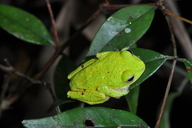|
Pseudophilautus poppiae (Meegaskumbura & Manamendra-Arachchi, 2005)
| family: Rhacophoridae subfamily: Rhacophorinae genus: Pseudophilautus |
| Species Description: Meegaskumbura M & Manamendra-Arachchi K 2005 Description of eight new species of shrub frogs (Ranidae: Rhacophorinae: Philautus) from Sri Lanka. Raffles Bull Zool Suppl 12:305-338. | |
 © 2011 Dr. Peter Janzen (1 of 10) |
|
|
|
Description Colour in life: dorsal and lateral parts of head and dorsum bright ‘luminous’ green; some individuals with yellow or red spots on dorsum. Dorsum spotted with black. Flank yellow. Inguinal zone and anterior thigh brownish-yellow. Edges of both lower and upper lips yellow or white. Upper arm yellow or greenish-yellow dorsally. Outer edge of lower arm with a longitudinal white band. Inner side of both upper and lower arms yellow. Outer edges of shank, pes and toe 5 white. Pes ventrally white. Venter pale yellow (Meegaskumbura & Manamendra-Arachchi, 2005). Colour in alcohol: Dorsum and flanks ashy pink with whitish yellow (rarely with red) patches and scattered black dots. Lower flank yellow. Upper lip yellow. Limbs dorsally ashy pink with scattered black dots. Posterior thigh yellow. Venter pale yellow (Meegaskumbura & Manamendra-Arachchi, 2005). Distribution and Habitat Country distribution from AmphibiaWeb's database: Sri Lanka
Life History, Abundance, Activity, and Special Behaviors All frogs of this genus are terrestrial direct developers (Bahir et al. 2005). Possible reasons for amphibian decline General habitat alteration and loss Comments P. poppiae is closely related to P. femoralis and P. mooreorum which are separated from each other by a 12S and 16S sequence divergence of 2.56–3.15% and cytochrome-b sequence divergence of 7.7–8.9% (Meegaskumbura & Manamendra-Arachchi 2005).
References
Bahir, M. M., Meegaskumbura, M., Manamendra-Arachchi, K., Schneider, C. J., and Pethiyagoda, R. (2005). ''Reproduction and terrestrial direct development in Sri Lankan shrub frogs (Ranidae: Rhacophorinae: Philautus).'' The Raffles Bulletin of Zoology, 12, 339-350. [link] Batuwita S, Udugampala S, DeSilva M, Diao J and Edirisinghe U. (2019). "A review of amphibian fauna of Sri Lanka: distribution, recent taxonomic changes and conservation." Journal of Animal Diversity, 1(2), 44-82. [link] Meegaskumbura M. & Manamendra-Arachchi K. (2005). ''Description of eight new species of shrub frogs (Ranidae: Rhacophorinae: Philautus) from Sri Lanka.'' Raffles Bulletin Zoology Supplemental, 12, 305-338. [link] Originally submitted by: Dayupathi Eranda Nipunika Mandawala (2021-07-31) Description by: Dayupathi Eranda Nipunika Mandawala (updated 2021-07-31)
Distribution by: Dayupathi Eranda Nipunika Mandawala (updated 2021-07-31)
Life history by: Dayupathi Eranda Nipunika Mandawala (updated 2021-07-31)
Comments by: Dayupathi Eranda Nipunika Mandawala (updated 2021-07-31)
Edited by: Michelle S. Koo (2021-07-31) Species Account Citation: AmphibiaWeb 2021 Pseudophilautus poppiae <https://amphibiaweb.org/species/6513> University of California, Berkeley, CA, USA. Accessed Nov 22, 2024.
Feedback or comments about this page.
Citation: AmphibiaWeb. 2024. <https://amphibiaweb.org> University of California, Berkeley, CA, USA. Accessed 22 Nov 2024. AmphibiaWeb's policy on data use. |



 Map of Life
Map of Life